Joseph Young 1823-1901
The census records state that Joseph was born in Otterburn 1823 as verified by his death date . Joseph appears on the 1881 and 1891 census records as a coal miner. As yet I can not find any trace of them on the 1861 Mickley census, although Thomas and Charles state they were born there, or on the 1851 census. Did they move to the Morpeth area if Jane is from there? In the electoral registers for Mickley Joseph appears on the years 1885, 1887, 1888, 1891, 1892 and 1895. He does not appear on 1896 BUT he is still on the 1901 census as shown below.
Josephs death was registered between Oct-Nov_Dec 1901 ref:
| District: | Hexham |
|---|---|
| County: | Northumberland |
| Volume: | 10b |
| Page: | 233 |
| Name | Relationship | Age | D.O.B* | Occupation | Place of birth |
| Joseph | Widower | 60 | 1821 | Coal Miner | Otterburn |
| Jane | D in Law | 23 | 1858 | Morpeth | |
| Thomas | Son | 27 | 1854 | Coal Miner | Mickley |
| Charles | Son | 17 | 1864 | Coal Miner (Brake man) | Mickley |
*Estimated, not actually on the census record
What this tells us is that Joseph must have come to Mickley by 1853 at the latest (when he would have been 30). Joseph would have been aged 40 when Charles was born and you would expect that if there had been any other children after Charles they would have figured on the census unless they died in infancy. Joseph's wife must then have died between 1863 and early 1881. What is curious about the 1881 record is that Josephs age is set at 60 . Surely he'd be 58 or 59? There is the marriage of a Joseph Young in the Hexham area in 1859
| Name: | |
|---|---|
| Year of Registration: | 1859 |
| Quarter of Registration: | Oct-Nov-Dec |
| District: | Hexham |
| County: | Northumberland |
| Volume: | 10b |
| Page: | 337 |
On the 1841 census there is a Joseph born in 1823 working as a Agricultural labourer in North Seaton township, Bedlington/Morpeth area for another Labourer called James Brown, he also appears on the 1861 census aged 43 with a wife called Elizabeth. Notice that OUR Josephs daughter in law Jane was from Morpeth and the replacement daughter in law from North Seaton. Is this sheer coincidence?
Questions:
1) There is a 10 year gap between Thomas and Charles, are there any other children? OR was Joseph married twice
2) What happened to Charles between 1881 and 1891? I need to search the 1891 census again for this information. He will be aged between 26 and 28. There is a Charles Young aged 26 married to an 'Elener' Young living with her father Edward Gibbon, wife Jane Gibbon and sister (also) Jane Gibbon. This Charles young says he was born in OVINGHAM. However plenty of people moved from Ovingham and Ovington to Mickley as the pits opened up so he MAY be our Charles Young. Indeed in 1901 he reverts his birthplace back to Mickley. There is a marriage of a Charles Young and Eleanor Gibbon in 1890 (O/N/D) in Newcastle.
| Name: | |||||||||
|---|---|---|---|---|---|---|---|---|---|
| Age: | 36 | ||||||||
| Estimated Birth Year: | abt 1865 | ||||||||
| Relation: | Head | ||||||||
| Spouse's Name: | Eleanor | ||||||||
| Gender: | Male | ||||||||
| Where born: | Mickley, Northumberland, England | ||||||||
| Civil Parish: | Mickley | ||||||||
| Ecclesiastical parish: | Mickley | ||||||||
| Town: | Mickley Square | ||||||||
| County/Island: | Northumberland | ||||||||
| Country: | England | ||||||||
| Registration district: | Hexham | ||||||||
| Sub-registration district: | Bywell | ||||||||
| ED, institution, or vessel: | 18 | ||||||||
| Neighbors: | View others on page | ||||||||
| Household schedule number: | 128 | ||||||||
| Household Members: |
|
John Tiffin is a boarder and Charles is a Miner brakeman?
3) Where are they on the 1871 and 1861 censuses?
4) Where is Joseph on the 1851, 1841 and 1831 censuses?
5) Where is the death certificate for Jane Young? She would have died between 1886 and 1890 therefore aged between 28 and 32. In 1886 there is the death of a Jane Young aged 28 (the correct age) in the register for Hexham for the period JUL-AUG-SEP.
This is certainly a record of her death as I have scanned the later records for other alternatives:

As Isabella was born in 1886 perhaps Jane died in or just after childbirth, there must be a record of Isabellas birth between 1885 and 1886. I couldn't find an Isabella at all BUT after switching the search to ALL female Youngs born in Hexham for those years I found BELLA registered between July and Sept 1885 which would mean she was indeed 5 years old when the census was taken in 1891, in fact she would have 5 and half or thereabouts
There were 3 pits in the Mickley area. There was certainly one at High Mickley, another nearer to Branch end and another to the west of Mickley Square called Mickley Colliery. All 3 were drift mines. All 3 were closed down in 1927 after the general strike. There were other pits at Prudhoe castle and West Wylam. As a consequence of the loss of employment all the Tyne Valley villages have rapidly declined in population. Stocksfield has replaced Mickley as the area of highest population density though this is as a residential area rather than through any neighbouring industry. Mickleys population was displaced to West Wylam with the pit closures as well as the redevelopment of Mickley Square in the 60's which is presumably why Mary Ridley was moved there, in 1960 Mary would have been about 63, she was certainly still alive in the 70's as I remember visiting her with Grandma Strachan.
| House | Name | DOB | Relationship | age | Occupation | Place of Birth |
| (16) Mickley Sq. | Joseph | 1823 | Widower | 68 | Coal Miner | Otterburn |
| 2 rooms | Thomas | 1855 | Son | 36 | Coal Miner | Mickley Square |
| Mary Elizabeth | 1872 | Wife of Son | 19 | North Seaton | ||
| Joseph | 1882 | Grandson | 9 | Scholar | Mickley Square | |
| Margaret | 1883 | Grand daughter | 8 | Scholar | Mickley Square | |
| Isabella | 1886 | Grand daughter | 5 | infant | Mickley Square | |
| William | 1890 | Grandson | 1 | infant | Mickley Square |
The eldest 3 children are certainly those of Thomas and Jane his first wife. The infant William must almost certainly be the child of Thomas and Mary Elizabeth who had at least another 4 children after 1891 which become clear with the 1901 census due to be released in 2001. Certainly there is a Thomas Jnr who Grandma referred to as 'Uncle Tommy'.
Here is the 1891 census showing the Youngs
| Address | Name | Age | Occupation | Place of Birth |
| 16 North Side Low Row Mickey Square | Thomas Young | 46 | Colliery Banksman | Mickley |
| Mary Elizabeth | 29 | Housewife | North Seaton | |
| Joseph | 19 | Labourer in coke ovens | Mickley | |
| William | 11 | Mickley | ||
| Hannah | 7 | Mickley | ||
| Thomas | 5 | Mickley | ||
| Mary E | 3 | Mickley | ||
| Jane | 2 months | Mickley | ||
| Joseph Young | 78 | Retired furnace fireman in coalmine | Otterburn |
Note that there is now no record of Margaret (who would be 18) and Isabella who would be 15. Note also that after Mary Elizabeth was born there is a Jane so both wives are commemorated in his children's names by Thomas Young.
Stuart Rowlands is very informative about 'Low row'
Low Row and High Row were part of the older 19th century miners houses
Margaret Young: There is only ONE Margaret Young on the 1901 census of that age (there is another in Mickley who is 19 so just too old).
| Address | Name | Age | Occupation | Place of Birth |
| Commercial Inn | John Murray | 41 | Stone mason and innkeeper | Carlisle |
| Margaret (wife) | 28 | High Mickley | ||
| John | 1 | High Mickley | ||
| William Jackson (Bro-in-law) | 48 | Mickley Square | ||
| Margaret Young | 18 | Servant | Mickley Square |
As Mary Elizabeth Young/Strachan wasn't born until 1912 Margaret must have moved to Corbridge sometime between 1901 and 1911. As we will later see there is a Margaret Jane GUY living with Robert Henry Guy in 1930 in Hill Street in Corbridge. Mary Elizabeth would have been aged about 18 then. You can see from the Young's family tree that Margaret's mothers name was JANE. Is it just sheer coincidence that that is the same middle name that Margaret Jane Guy has? Margaret would have been 28 or 29 when Mary Elizabeth Young was born. Robert Guy would have been more or less the same age.
Here is the entry for her birth in the register of births for the months Jan-Feb-Mar 1883:
Here is the Death registration for Margaret Guy aged 50 registered between Oct, Nov and Dec 1933.
On the Commercial Inn and more Stuart Rowlands writes:
I am not certain as to the location of
Mickley had a number of other pubs (including the Hare and Hounds and Miners Arms), the only one remaining is the Blue Bell at Mount Pleasant. The Social Club (a brick building) was first built around 1900 and rebuilt about 20 years later after a fire. This is still in use today. It stands on the main road (A695) going through the village. Opposite is the Miners Welfare Hall built as a reading room/games room etc. around 1894. It later became a church hall for St Georges Church. However it was in a difficult location with poor access and has not been used for several years, and is now up for sale. Mickley still has a post office/shop and school. Its former cinema is now a pub/club - the Glenside.
Although there were a number of small pubs around, the area around had a tradition for Temperance and Stocksfield village (the land owned by Lord Allendale) has no public houses in spite of a population of around 3000 people. Some of the miners houses in Mickley Square still remain but the majority were demolished after the Second world war and most of there inhabitants were moved to new houses in nearby West Wylam where the mine was still in operation (this closed in the 1960's). A 'new' housing estate was built in the 1960's (Riding Dene), where most of the present population live.
Regards
Stuart Rowlands
Thomas Young Snr
We know that Thomas' first wife, Jane, died in 1886 and that he must have remarried in a very short space of time, circa 2 years. Did she die in childbirth in 1886? Isabella was born about a year before the death of her mother but it is not impossible. Joseph was a widower and Charles must have moved out of the house meaning that there was no woman in the house to look after the small children while the men were at work. In 1891 as we know Mary Elizabeth had arrived and already given birth to a son, William, aged 1.
Thomas appears on the electoral registers for 1885, 1887, 1888, 1891, 1892, 1897 (but not 1895 or 96!), 1898, 1899, 1905, 1910 and 1920. In 1925 Thomas would have been aged 70 so I suspect he died between 1921 and 1925.
Research: Find Thomas Young's
death registration and marriage registrations
Grandma recalls that he played in the colliery band, the trumpet apparently. Also that he had a daughter called Beryl who lived at Branch End. In the first world war Tommy was shot through the lung. If he indeed served then Tommy must have been born before 1898 and of course after 1891. William would have been 24 on the outbreak and Joseph Jnr 32 so both could have served in W.W.I. I would assume if any of them didn't survive the war then perhaps their names would appear on the war memorial next to Broomley school. Investigation of the memorial though revealed that there are NO Youngs commemorated there. There is only ONE Young listed on the War memorial at St Georges, Mickley a Pte. T. Young.
Thomas Jnr appears on the 1920 register of electors, he would have been in his 20s by then. In 1920 the following were listed as registered to vote at 10 North View Terrace, Mickley Square:
Mary Elizabeth (aged 48)
William
(aged 30)
Thomas
(aged 65)
Thomas Jnr
(aged 28 max.)
Tommy married Winnie Herdman (a common Mickley name) and Beryl's married name was Dennis. Tommy worked at Hedley pit as a pitman and lived at Branch End, Stocksfield.
The pit row houses were demolished in the 1960s and the inhabitants removed to West Wylam. Auntie Mary Ridley was certainly one of those moved there.
This leaves the wherabouts of Charles Young, Joseph the younger and William a mystery. In 1914 Charles would have been 50 which surely would rule him out of conscription? Joseph would have been 32 and William would have been 24. We know that William was alive in 1920 so only Joseph could possibly have died in the war. On searching the Commonwealth war graves commission website I found one possible commemoration.
JOSEPH YOUNG
Private
3060
1st/5th Bn., Northumberland Fusiliers
who died on
Monday, 24th May 1915
Bear in mind I have so far only looked at the Northumberland Fusiliers and Durham Light Infantry graves, also a few simply have an initial not a full name and only give date of death not age or parentage.
|
Above |
|
Mickley Coal Co Ltd., Stocksfield |
Mickley |
Stocksfield |
Thomas Bates jnr. |
R Gerghty |
|
Mrs. J T Walker Hedley Stocksfield-on-Tyne |
Hedley Bank |
Stocksfield |
Wm. Walker |
|
RJ Bewick and Bros Murton Chambers, Grainger St., Newcastle-on-Tyne |
Mickley Bank/Mickley Grange |
Stocksfield |
Wm. Bewick |
The Mickley pit must have been worked out or closed down almost in entirety after 1928 because by 1945 there were only 6 men working below ground and the largest pit in the area had shifted to Hedley park...
|
RJ Bewick, Murton Chambers, Grainger St., Newcastle-on-Tyne |
Mickley Bank |
Stocksfield |
| Mickley Coal Co Ltd., Mining Dept., Akenside House, Newcastle-on-Tyne |
Hedley Park |
Stocksfield |
RW Ord |
TJ Hall |
|
Mickley |
TJ Hall |
|
Shilford Coal Co Ltd., Murton Chambers, Grainger St., Newcastle-on-Tyne |
Whinfield Drifts |
Stocksfield |
|
Mrs JT Walker, East Ridley Farm, Stocksfield-on-Tyne, Northumberland |
Hedley Bank |
Stocksfield |
R Jones |
| Location: | Hedley Bank Colliery, Stocksfield |
| Map Ref: | |
| Opened: | |
| Closed: | |
| Owners: | |
| ???? - John T. Walker | |
| ???? - Mrs. J. T. Walker | |
| Output: | 1896 - Coal: Household. |
| 1902 - Coal: Household. | |
| 1914 - Coal: Household. | |
| Employment: | 1896 - 9 (8 below, 1 surface) |
| 1902 - 15 (11 below, 4 surface) | |
| 1914 - 20 (16 below, 4 surface) | |
| 1945 - 23 (18 below, 5 surface) | |
| Seams Worked: | 1914 - Six Quarter, Brockwell |
Mickley Bank Colliery
| Location: | nr. Prudhoe 11½ miles [19 km] W of Newcastle |
| Map Ref: | (Sheet 88) NZ070605 |
| Maps: | 1861 [link to www.old-maps.co.uk], Mickley Bank Colliery is shown at the top of the displayed map |
| 1898 from Reid's Handy Colliery Guide | |
| 1928 from Reid's Handy Colliery Guide | |
| 1951 from the Guide to the Coalfields (Colliery Guardian) | |
| Opened: | |
| Closed: | |
| Owners: | |
| ???? - Elizabeth Bewick | |
| ???? - Isabella Bewick | |
| ???? - R. J. Bewick | |
| Output: | 1896 - Coal: Household. |
| 1902 - Coal: Household. | |
| 1914 - Coal: Household. | |
| 1951 - Coal: Manufacturing, Steam. | |
| Employment: | 1896 - 9 (7 below, 2 surface) |
| 1902 - 11 (9 below, 2 surface) | |
| 1914 - 10 (8 below, 2 surface) | |
| 1945 - 9 (8 below, 1 surface) | |
| 1951 - 16 (14 below, 2 surface) | |
| Seams Worked: | 1914 - Six Quarter |
| 1951 - Six Quarter, Five Quarter, Tilley |
YOUNG - N'BLAND 1850-1919
[Source, the lists of deaths in the Mines Inspectors Reports]
John Young
04/11/1867, 12, Driver, Dipton, J Bowes and Partners, Newcastle-on-Tyne,
Northumberland, Crushed by tubs.John Young
17/04/1871, 52, Deputy, West Cramlington, W Maud and Partners, Newcastle,
Northumberland, Fall of stone.George Young
02/11/1875, 16, Putter, West Cramlington , JC Lamb and Co, Newcastle,
Northumberland, Fall of stone. Died 16th Nov.Robert Young
24/10/1894, 36, Hewer, Brownrigg, J Armstrong, , Northumberland, Inspection
made. Suffocated by stythe. The deceased it would seem had gone into the place where he met his death either out of curiosity or to get something. He had been working there on the previous day with the owner the mine but owing to the foul air he had been forbidden to go in by the owner.Robert Young
08/12/1899, 17, Small trimmer , Seghill, Joseph Laycock and Co, Northumberland, He was passing along the railway branch and was knocked down
by a waggon moving slowly down. He was walking towards the waggon but had evidently been looking in another direction.George Young
25/05/1906, 34, Hewer, Choppington, Bebside Coal Co Ltd, , Northumberland,
Died June 15. Deceased and another hewer, the president of the local union, were hewing together during the fore shift in broken workings in the Bensham seam, 2 feet 6 inches thick: of the crossbent flat of the A pit. The lift had not advanced far and only a little top stone had been taken down at its entrance. The stone, a blue metal, had been complained of by the hewers in the back shift the day before and had been attended to in the night. When deceased and his 'marrow' (Marra = workmate) reached the place, after seeing the deputy, who had examined it an hour or two before, they set a prop and plank under the brow. The deputy visited them at 6.40am. and ended this plank. After he left them deceased went into the old and drilled a hole about the middle of the seam in the solid to blow out about 18 inches of coal, and as candles were use fired the shot himself; it blew out, simply cracking the coal, and made a loud report, which the deputy heard when 280 yards away. After the shot, while deceased was filling coal near the brow, a stone fell from it, about 7 feet long, 1.5 feet wide and 14 inches thick, inflicting serious injury. The shot was fired in contravention of the regulations of the colliery, and may have contributed to the accident in two ways 1st, by the extra concussion shaking the roof stone, and, 2nd, their anxiety to remove traces of it may have led to the neglect of precautions as regards the roof. Deceased was treated home until June 5th, when he was removal to Newcastle Infirmary, where he died. The Local Inspectors reported, Found a hole in solid coal, having been fired and stone falling from brow, and in our opinion no fault to find with the officials.¹Robert Young
01/03/1906, 62, Hewer, North Walbottle, North Walbottle Coal Co Ltd, Northumberland, Died 2nd Mar. Deceased on his way home from work in the
Throckley Coal Company's Blucher pit, travelled down a surface self-acting incline occupied by she North Walbottle Coal Company. As he passed the bank-head the attendant there told him to wait, as trucks were to be run, but he refused and said he would walk though sets. He walked down 157 yards, when the attendant who had started the incline saw the three loaded 15-ton trucks that were beginning run past him, and, after they had passed saw him lying between a fence and the line of rails on which the loaded trucks had ran, where there was a space of about 4.5 feet. Both his legs were cut off below the knee and one arm was nearly severed. lie had been dragged 13 yards. The incline attendant said he did not think deceased had been attempting to ride, but that, as it was a greasy day, he had slipped. He was taken to Newcastle Infirmary, where he died next day. Notices prohibiting trespassing on the incline are posted up but little attention is paid to them. The Jury added to their verdict the following, We think not sufficient protection is afforded the public where the accident took place.¹Angus Young
14/01/1909, 21, Hewer, Cramlington, Cramlington Coal Co Ltd, Northumberland, Fall of roof stone at face of stall.
George Young
06/12/1910, 35, Hewer, West Mickley , West Mickley Coal Co Ltd, Northumberland, Fall of stone
Notes: It was the duty of the mine owners to protect their employees by forbidding the riding of waggons to and from the coal face (although the temptation was very strong indeed to do this and as a consequence many died), propping the roof of the drifts properly to prevent the falling of stone and to guard against foul air (Stythe) by having detectors such as canaries (each pit had 2 canaries each and were first introduced in 1911 until finally being made redundant in 1986 much to the sorrow of the remaining miners), safety lamps (Davy invented his lamp in 1815, Stephenson invented his rival safety lamp in the same year and is known as the 'Geordie'), the mines inspectorate was established in 1850 for the protection of miners. Firedamp is a mixture of methane and air. Before the safety lamps of Davy and Stephenson a man called a fireman would approach an area of firedamp with a lit candle on the end of a long pole and ignite the gas, because of his protective clothing which resembled a holy man he was nicknamed the Penitent. A build up of carbon dioxide and air was called 'blackdamp', 'Stythe' or 'choke-damp' and that would be found in low lying parts of the mine. Every pit measured the air pressure as differences in air pressure could draw out or prevent build ups of these noxious gasses.
The 1842 Mines and Collieries Act, banned all women, and children under 10 from working underground. No-one under 15 years was to work winding gear in mines.
In 1870 the Education act made primary education compulsory for all children.
Between 1870 and 1880 with the collapse of British agriculture (due the mass import of cheap American corn) the agricultural population decreased by 100,000. Many of these would have migrated to the coal mines.
Research: When were the seams opened at Heworth, Mickley and Framwellgate as that may determine when they arrived

Mickley Square c. 1920 (note the chapel on the left foreground)
In the right middle ground a horse and cart is making a delivery to the local Co-Operative store. Now the Jiggery-Pokery. Mickley is best known as the birthplace of Thomas Bewick (b. 1753) the artist and engraver. Former local football legend Bob Stokoe is also a Mickley native. Mickley is actually made up of 3 small hamlets. Mickley Junction, Mickley Square and High Mickley although they are now contiguous. Presumably before the coal industry opened up Mickleys hillsides with a vengeance the villages would have been much smaller and devoted to fishing and farming. With the opening of the 3 mines the population of Mickley exploded so much (in 1911 the parish total reached 2,969 souls) so that the residents demanded a railway station on the Carlisle to Newcastle line. They duly got one but it only stopped twice a week!. There was a ferry at Mickley that carried folk to and from the 'Holiday cottages' across the Tyne.
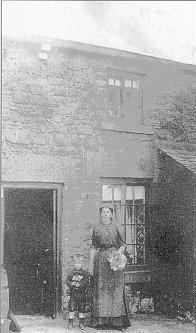
Woman and child outside a typical 3 roomed house in 1914

Station road Mickley c. 1920. What is the building on the right
with the shop front?
This was the main road down to the rail stop. The buildings on the right must be shops of some kind. We know that from the photo above the Co-Op store was on the main road. These buildings could be a public house, funeral parlour or anything.
There are two places of worship in Mickley, St George's Chapel. Church and the Methodist hall.
St George's

The first building on the site of the present church was a 'Chapel of
Ease' (1823), as the area was part of the ancient parish of Ovingham. Mickley
was given parochial status in 1867 and the 'Chapel' was extended in 1884
by the addition of a chancel, transepts, and a porch and steeple. The original
building became the nave and the church has had no further structural alterations
since 1884. Both the building and alterations were paid for by Mr Battie
Wrightson the land and coal owner of the period.
[The Newcastle Diocesan Gazetteer (1982), page 38.]
In the vestry is a photograph of the choir dated 1936:
D. RUDDICK
L. BROWN
T. SPICER
R. PRICE
J. DONNELLY D. BALLANTYNE
W. ROBERTS
J. BATEY
W. RIDLEY
D. WILLIE
P. HOWDEN T.
NICHOLSON
J. TURNER
H. HOLDEN
H. TAYLOR
REV. F. PATTISON VICAR 1930-1950
W. RIDLEY ORGANIST & CHOIRMASTER
A brass plate on the organ reads:
To the Glory of God
and in Memory of
RICHARD HERBERT WRIGHTSON
Patron and Benefactor
Erected 1894.
One stained glass window behind the altar reads:
ERECTED TO THE MEMORY OF SAMUEL
& MARY ANN LITTLE OF THIS PARISH
BY THEIR SON JOSEPH 1921
The following is a list of the Vicars in the parish since its inception.
1868. J.A. Collingwood-Maughan left to become
first Vicar of Prudhoe
1884. William Jesson died March 16th 1893
1893. G.J. Woodward
1897. John Turner
1904. D. Waters
1905-1930. Thomas Stenhouse
1930-Sept. 1951. W.F. Pattison
1952-57. Athol Simpson
1958-1963. Harold H. Baker
1963-1965. in Charge C. Bartlett Vicar of
Ovingham
1965-1995. J.E. Symons
The Methodist hall and Methodism
Primitive Methodism was very energetic in the Tyne valley and there are halls in Mickley, Shotley Bridge and Stocksfield as testimony to this. Methodism came to Newcastle under the mission of William Clowes in 1821, he returned each year for the next few years and by the 1830s had become very well established along the Tyne valley. The Methodist hall is dated to this period. The Methodist's main mission in the pit villages was to turn away the men from drink and towards god and healthy pursuits. Cycling and music were the strategies they employed.

Here a small band of men and boys, the Mickley cycle club, gather
in 1914 for a ride. Temperance bars also sprang up where the Methodists
were strong. A temperance bar sold soft drinks and cordials with a wide
variety of ingredients. Perhaps the Temperance Hotel at Stocksfield station
was such an establishment?
Cherryburn and Bewick
Thomas Bewick may fairly claim to be the father of modern English book illustration. His wood engravings of animals (started in 1785) were published in A General History of Quadrupeds and made him immediately famous; his two volume History of British Birds (1797, 1804) confirmed his greatness as a designer, illustrator and engraver.
These two publications went through various editions, and were still being printed from original wood blocks well into the 19th century: in fact, one of the great marvels of this method of work is that his blocks have been known to yield 900,000 prints without being worn out! The secret of the fine detail and the durability of the blocks is due to his working on the end grain and not on the plank, as had been used previously for wood-cuts (notably in early printed book illustration). This, however, constrained the size of his blocks to quite small dimensions -- most of his pictures are no more than 8cm square and many are much smaller. His only really large block, the famous Wild Bull at Chillingham, is still only 20 x 14cm and partly split during use.
Bewick was born in August 1753, at Cherryburn House, near Eltringham, Northumberland, and was apprenticed to a Newcastle engraver at the age of fourteen; he died on 8 November 1828, and is buried in Ovingham churchyard, across the river from Cherryburn.
Grandma said that he was adopted by a couple in/from Hexham or that Robert was from Hexham therefore tracing his ancestors would be difficult if not impossible. Robert 'co-habited' with Margaret Young, they never married as apparently they couldn't afford to, this is not at all uncommon. All we know of Robert is as follows. He worked on the 'Corstopitum diggings' (the excavation of the Corstopitum site) between 1906 and 1914.Grandma said he was a butcher or butchers apprentice at some point. My mother recalls that he drove a cart to 'deliver the meat'. As a butchers apprentice you can assume that that would have been one of his duties. We have two photos of him both from the Corstopitum collection. After Margaret died 'he lived with a Mrs Guy'. Grandma was always very touchy about the name Guy and was adamant about the name Strachan or Young. As we will see below this is how she preferred to be known when registering the births of Nancy and Doreen
In 1930 on Hill street are listed a Robert Guy and a Margaret Jane Guy! Very curious indeed.
On the electoral register for 1939 are:
Isabella Guy
Robert Guy
Mary Elizabeth Guy
all at Hill Street. Isabella must be the Mrs Guy Grandma referred to but she is clearly not the first.
On the Electoral register for 1945 listed at No. 3 Hill street are:
Mary E. Strachan
Thomas Strachan
Grandma claimed she was born at Number 3 and didn't leave that house until she moved to Trinity court in 1970? Wasn't she 58 when she had to move?
The 1901 Census holds this information:
| Address | Name | Relation to Head | Age | Occupation | Place of Birth |
| Hill Street | Joseph Guy | Head | 73 | Tailor | Corbridge |
| Sarah | Wife | 63 | Corbridge | ||
| Hannah | Daughter | 40 | Charwoman | Newcastle | |
| Robert Henry | ADOPTED SON | 17 | Butcher | Hexham |
This is pretty conclusive that Roberts name was actually Robert Henry Guy who was born in Hexham (and also registered there), was a butcher and most tellingly was adopted. Why was he adopted? Not only that but Hannah must be older than 40, she would be 42/43 if we look at the previous 4 censuses (I can't find her on the 1861 census but she would have been 3 or 4 then). Could it be that Hannah was born a Seatree and isn't actually Josephs daughter, she later had an illegitimate child who again Joseph adopted into his family?
Joseph died in 1906
| Name: | |
|---|---|
| Estimated Birth Year: | abt 1828 |
| Year of Registration: | 1906 |
| Quarter of Registration: | Jul-Aug-Sep |
| Age at Death: | 78 |
| District: | Hexham |
| County: | Northumberland |
| Volume: | 10b |
| Page: | 234 |
Sarah died a year later in 1907
| Name: | |
|---|---|
| Estimated Birth Year: | abt 1837 |
| Year of Registration: | 1907 |
| Quarter of Registration: | Jul-Aug-Sep |
| Age at Death: | 70 |
| District: | Hexham |
| County: | Northumberland |
| Volume: | 10b |
| Page: | 184 |
The 1891 census has even more information
| Address | Name | Relation to head | Age | Occupation | Place of Birth |
| Middle Street | Joseph Guy | Head | 63 | Tailor | Corbridge |
| Sarah | Wife | 53 | Corbridge | ||
| Hannah (Seatree) | Daughter | 32 | Newcastle | ||
| John (Seatree) | Son | 22 | Grocers assistant | Corbridge | |
| Thomas | Son | 18 | Labourer | Corbridge | |
| Sarah J. | Daughter | 13 | Telegraph Deliverer | Corbridge | |
| Robert H. | Son | 7 | Scholar | Hexham |
So between 1891 and 1901 the family moved from Middle Street to Hill Street and also Sarah, Thomas and John moved out. I have a copy of this page from the census here. It seems a bit odd that Joseph Guy, a tailor with 4 of his own children should adopt another child? Was Robert the son of a relative? Did he change his surname? Was he the son of Hannah and thus his grandson by default? Why was Hannah still living at home at the age of 40? Would it be so surprising to discover that Hannah was indeed Roberts mother? John Seatree/Guy may well have died in 1893 as he doesn't appear on the 1901 census.
| Name: | |
|---|---|
| Estimated Birth Year: | abt 1870 |
| Year of Registration: | 1893 |
| Quarter of Registration: | Jan-Feb-Mar |
| Age at Death: | 23 |
| District: | Hexham |
| County: | Northumberland |
| Volume: | 10b |
| Page: | 1 |
The 1881 Census shows them living at number 12 Middle Street, Corbridge
| Address | Name | Relation to Head | Age | Occupation | Place of Birth |
| 12 Middle Street | Joseph Guy | Head | 56 | Tailor | Corbridge |
| Sarah | Wife | 44 | Corbridge | ||
| Hannah Seatree | Daughter? | 23 | Corbridge? | ||
| John (Seatree) | Son | 12 | Corbridge | ||
| Thomas | Son | 8 | Corbridge | ||
| Mary A. | Daughter | 5 | Corbridge | ||
| Sarah J. | Daughter | 3 | Corbridge |
Notice Hannah Seatree. There is a Hannah Seatree registered in Newcastle J/A/S 1857 that is almost certainly her. There is also a George Seatree in 1851 again in Newcastle, a Henry in 1883 amongst others in Newcastle. In 1884 there is a Joseph Guy Seatree J/F/M Vol 10b Page 310 registered in Hexham, Hannah would have been 25 then. A male child was born and died in O/N/D 1883 vol 10b page 194 with the surname Seatree. Was he an illegitimate child of Hannah who then went on to produce Robert Henry Guy a year later? So... I conclude that Joseph Guy married Sarah 'Seatree' who had two children, Hannah then produced two children (the first died) and Joseph adopted Robert Seatree Guy as his own son when in fact he was the son of his previously adopted daughter Hannah.
There is also a William Seatree registered in 1899 A/M/J 10b 379 but his parents are from Winlaton and they are living in Prudhoe in 1901 he also died in 1903 poor lad.
Now in 1871 they are living in Back Row, Corbridge. Bear in mind in the 1871 census ages were rounded up to the nearest 5 years usually.
| Address | Name | Relation to Head | Age | Occupation | Place of Birth |
| Back Row | Joseph Guy | Head | 41 | Tailor | Corbridge |
| Sarah Guy | Wife | 32 | Corbridge | ||
| Hannah Seatree | Daughter | 14 | Newcastle | ||
| John Seatree | Son | 2 | Corbridge | ||
| Joseph Guy | Son | 5 months | Corbridge |
A Joseph Guy married in 1869 which would fit with his son Joseph being born within 2 years of that after inheriting the two Seatree children. Young Joseph died in 1873 which is why he doesn't appear on the 1881 census (d.1873 Oct-Nov-Dec Hexham Northumberland Vol 10b Page 222).
| Name: | |
|---|---|
| Year of Registration: | 1869 |
| Quarter of Registration: | Oct-Nov-Dec |
| District: | Hexham |
| County: | Northumberland |
| Volume: | 10b |
| Page: | 387 |
The Seatree mystery deepens as there are another Hannah (who would have been 23/24 in 1881) and a John aged 2 who was registered in Hexham J/F/M 1869
In 1861 Josephs father and mother are listed but no sign of the c.33 year old Joseph. As the 3 year old Joseph is also a Guy perhaps he is Ann's illegitimate son. Josephs brother John is 38 and working as a servant for a family called Douglass in Humshaugh who were butchers. It looks like John died in 1864.
| Address | Name | Relation to Head | Age | Occupation | Place of Birth |
| Joseph Guy | Head | 65 | Farm Labourer | Corbridge | |
| Mary | Wife | 53 | Hexham | ||
| Ann | Daughter | 24 | Farm Labourer | Corbridge | |
| William | Son | 22 | Farm Labourer | Corbridge | |
| Joseph | Grandson | 3 | Corbridge |
In 1851 Joseph Guy is listed with his family.
| Address | Name | Relation to Head | Age | Occupation | Place of Birth |
| Joseph Guy | Head | 55 | Agricultural Labourer | Corbridge | |
| Mary | Wife | 49 | Hexham | ||
| John | Son | 28 | Agricultural Labourer | Corbridge | |
| Joseph | Son | 23 | Tailor | Corbridge | |
| Thomas | Son | 21 | Agricultural Labourer | Corbridge | |
| Ann | Daughter | 15 | Corbridge | ||
| William | Son | 12 | Corbridge |
In 1871 Joseph Snr is still very much alive at the grand old age of 75 and still working perhaps in Aydon Quarry? He doesn't appear on the 1881 census.
Here are his death details
| Name: | |
|---|---|
| Estimated Birth Year: | abt 1796 |
| Year of Registration: | 1874 |
| Quarter of Registration: | Jul-Aug-Sep |
| Age at Death: | 78 |
| District: | Hexham |
| County: | Northumberland |
| Volume: | 10b |
| Page: | 205 |
1871 census
| Address | Name | Relation to Head | Age | Occupation | Place of Birth |
| Joseph Guy | Head | 75 | Masons Labourer | Corbridge | |
| Mary | Wife | 70 | Hexham | ||
| Ann | Daughter | 35 | Field Labourer | Corbridge | |
| William | Son | 32 | Agricultural Labourer | Corbridge | |
| Joseph | Grandson | 12 | Scholar | Corbridge | |
| Ann | Granddaughter | 9 | Scholar | Corbridge | |
| Hannah | Granddaughter | 5 | Scholar | Corbridge | |
| Robert | Grandson | 1 month | Corbridge |
William died in 1903
| Name: | |
|---|---|
| Estimated Birth Year: | abt 1839 |
| Year of Registration: | 1903 |
| Quarter of Registration: | Oct-Nov-Dec |
| Age at Death: | 64 |
| District: | Hexham |
| County: | Northumberland |
| Volume: | 10b |
| Page: | 249 |
In 1881 I found Joseph aged 21 and working on Main St as a helper in stables (Domestic groom). So two Joseph Guys living and working in Corbridge at the same time, this younger Joseph would be our Josephs nephew by his sister Ann.
In the 1851 census there is a niece called Jane Guy who is at the Brown household in Aydon. I assume then that Isabella Brown was originally a Guy.
| Address | Name | Relation to head | Age | Occupation | Place of birth |
| John Brown | Head | 43 | Corbridge | ||
| Isabella | Wife | 41 | Corbridge | ||
| Jane | Daughter | ? | Corbridge | ||
| William | Son | 6 | Corbridge | ||
| Ralph | Son | 5 | Corbridge | ||
| Jane Guy | Niece | 14 | Corbridge |
We know that Margaret Young died in 1933 and it seems likely that Robert married or at least co-habited with Isabella Guy. Between 1939 and 1945 Robert died.
There is a Robert Guy registered in Gateshead in Apr-May-Jun 1883 but this same Robert Guy appears in the 1891 and 1901 census as living in Felling wheras the 1819 and 1901 census for OUR Robert clearly state he was born in Hexham yet there is no birth record for a Robert Guy born in Hexham in 1883 or 1884.
Research: Find the death registration of Robert Henry Guy
He was certainly around when Margaret his granddaughter was born c 1934 as Grandma recalls that he would read to her and tried to teach her to read. He had several jobs including delivering the ash closet scrapings to the local farmers for fertiliser as well as apparently being a gardener at Aydon castle. Robert died by drinking poison, he was apparently suffering from something incurable and presumably didn't want to be a burden or suffer too much. He may have worked at Aydon colliery at some time too as Thomas Strachan was either his friend or lodger. They were of a similar age apparently. The colliery at Aydon was called Aydon Quarry. There were plenty of other pits called 'Quarry' in the area that may well have been a coal quarry rather than a drift mine. I have located Aydon Quarry on a map dated 1828 which you can see here.
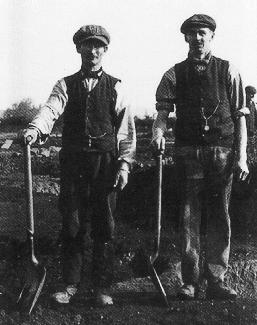
Local characters of Corbridge were Tommy Akenhead, 'Teacake' Watson, 'Chew' Younger and 'Kipper' Marmion.
Robert Henry Guy at the Corstopitum dig
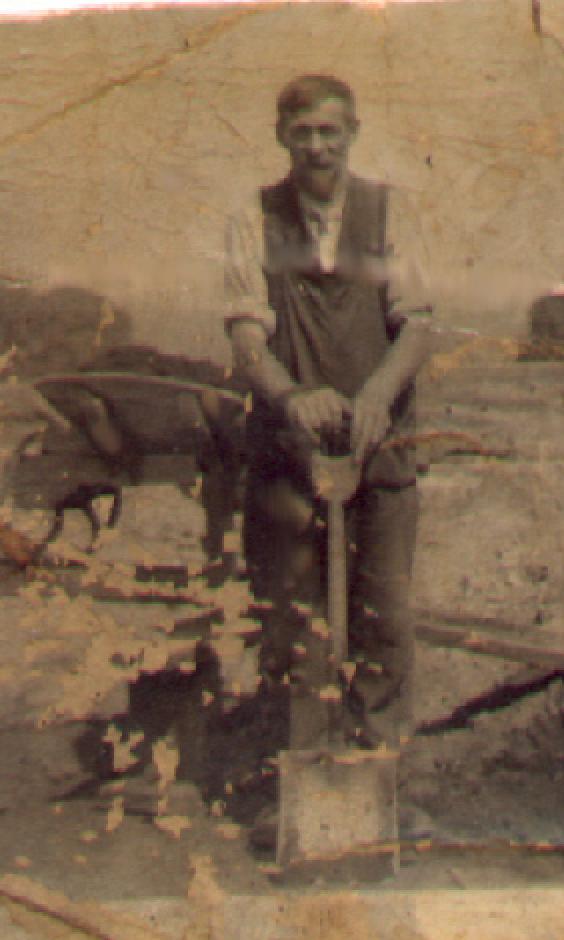
R.Guy in close up
The Strachans
"Obserare portam nocte fieri potest at non mendacis os!"
Thomas Strachan and Mary Elizabeth Young
Mary Elizabeth Young was born on 12th October 1912.
Tommy's family hail from Inverness ALLEGEDLY. I am aware of there being 3 of them, Thomas, William and the father of Clarice and Lily. Tommy worked at Acomb coal mine and died in 1949 aged 67. His brother William/Willie or John was by all accounts a bit of a ladies man (that's where I get it from!) and fought in the first world war. During one attack he had his kilt shot off. This may of course be the only tale he was willing to tell of his service, he certainly lived to tell the tale anyway. Tommy was born in 1882 so would have been too old for service in either war. All 3 Strachan brothers must have been drawn to Hexham/Corbridge for some reason. As we know Tommy worked in Acomb colliery perhaps they came south to seek employment in the Tyne Valley mines. Acomb Colliery operated between 1914 and 1950 with a gap between the end of 1914 and 1921 to sink new drifts to the Acomb seam. I hazard a guess that they came sometime around 1921 but not before.
Clarice lived in Priestfields estate, Hexham. Clarice handled Nancy's death arrangements but inadvertently handed over Doreen's birth certificate rather than Nancy's. Apparently Tommy's mothers name was Nancy but was known as 'Agnes' or vice versa.
There is a marriage of a Clarice Madeline Strachan to a Mr Chilton in JUL/SEP 1940. Clarice's fathers name is JOHN STRACHAN a coal miner (for a change)
This is George Chilton. Clarice and George had Ann ('1 year older' than mother so born in '41/42), John and George. Clarice's family were all in the Salvation Army hence Grandmas links to the Salvation Army in Hexham. Note the Clarice M. initial.... note also that John could have been named after his grandfather, Ann after her grandmother and George after his father.
Here is Anns birth registration for Jan/Feb/Mar 1941. Note mothers maiden name is indeed Strachan as we'd expect
John and George moved away and Ann stayed in Hexham. John and George must have been younger than Ann.
Clarice wasn't the daughter of Willie. There is a Lily/Lilian involved too somewhere who was probably Clarice's sister and there was one other sibling of Tommy and Willie who would be the Father of Clarice and Lily. In fact Lilian Strachan was born in 1917. Lily was one of 3 kids and daughter of the third Strachan. The third Strachan was a boy otherwise Clarice STRACHAN wouldn't have been a Strachan. Clarice's marriage certificate names her father as JOHN Strachan a deceased coal miner so we are looking for a man who died before he was 40. One of the witnesses is Annie Chilton, perhaps that is George's mother hence the daughter being called Ann, she could of course also be George's sister. There is an Annie Chilton born In Hexham in 1920 (J/F/M) whose mothers surname is Patrick and another in Haltwhistle in 1907 (O/N/D). There is a George Chilton born in 1917 (J/A/S) in Hexham whose mothers' surname was Patrick. I conclude then that that is our Chiltons and it was his sister who was one of the witnesses.
On the marriage certificate Clarice's address is 10 St Helens Lane, Corbridge and George is listed as an Iron Moulder aged 23 of 4 Cecil Terrace, Hexham. George's father is John Chilton a deceased Stone mason. The date of the marriage is August 3rd 1940.
There is a John Chilton born (or at least registered) 1886 in Hexham 1886 (A/M/J) who would have been 31 when George was born and 34 when Annie was born. There is a marriage in (O/N/D) 1910 and within the year another John Chilton was born in Hexham ( I suspect 1st August 1910 as there is a John who died in 2003 aged 92 in Hexham) and the following year a John L. Chilton in 1911. In 1901 there is a John Chilton, Stone Mason living in Hexham aged 23?
| Andrew Chilton | 25 |
| George Chilton | 58 |
| John Chilton | 23 |
| Mary Chilton | 60 |
| Nicholson Chilton | 27 |
| Isabella Watson | 15 |
The father George is a pipe maker and the sons Andrew and Nicholson are brick makers, presumably for the pit. They live in Gilesgate Bank. Gilesgate Bank is VERY close to Cecil Terrace.
There is another aged 15 a servant and apprentice Butcher living in Consett but it gives his birthplace as Horsley Butt. Another John (Thomas) Chilton is living in Newburn with a cousin from Hexham visiting so it is confusing as to who is the John we are looking for. 'Luckily' he died in 1906.
However in the 1891 census there is John Chilton born 1886 in Bedlington Station, father George, mother Mary, brother George Price Chilton aged 1 and John has a twin sister Margaret.
Clarice must have been in Corbridge for a while otherwise Mother wouldn't have known her.
| Name: | |
|---|---|
| Birth Date: | 18 Dec 1921 |
| Death Registration Month/Year: | Dec 1992 |
| Age at death (estimated): | 71 |
| Registration district: | Northumberland West |
| Inferred County: | Northumberland |
| Volume: | 1 |
| Page: | 2131 |
This is Clarice's death details that also give her DOB.
And here is her birth record
The mothers surname is Ackinclose and she is being registered in Tynemouth in 1921
In 1901 there is a family of Ackinclose living in Cullercoats and Annie H. Ackinclose is aged 6. The H is for HALL and she was registered in Tynemouth in 1895 (A/M/J quarter).
Dora was married someone called Taylor in 1925 in TYNEMOUTH.
George also married someone called Beatrice Ives in South Shields in 1915.
In 1917 LILIAN Strachan, mother Ackinclose was registered A/M/J 1917 , vol 10b page 372. So was Annie married in 1916?
There are VERY few Ackincloses around in the early 20th century, Ancestry.co.uk only shows 14 births (although there are obviously more than that).
On the 1901 census there are only 15 Ackincloses and they all live in Tynemouth or thereabouts. William James Ackinclose died in 1901 so there would be no further children (J/A/S 1901).
Are there any Chiltons left in Hexham?
Margaret Young Nee Grey would never have met her Grandmother as her Grandmother died in 1933 POSSIBLY giving birth to 'Young' Robert Guy aged 50.
Doreen Strachan was registered between JAN and MAR 1943, notice the mothers maiden name is given as Young.
Thomas and Mary's youngest daughter Nancy Strachan was registered as born between APR and JUN 1945:
Notice again that the mothers maiden name is registered as Young.
Between Jan 1948 and Dec 1955 in Northumberland West are the deaths of the following Strachans.
James R. Strachan who died aged 74 in Northumberland West in 1948.
Mary J. Strachan aged 66 dying in 1949 between OCT and DEC.
Hilda M. Strachan aged 47 between JUL and SEP 1954
There is a Nancy Strachan aged 0 dying in Jan-Mar 1952. Surely (as this is the only Nancy Strachan dying between these years the age is a misprint. She would have been 6 going on 7.
There is a Thomas Strachan aged 67 who is registered as dying in APR-JUN 1949. If this is indeed him and it is most certainly is him then he was born in 1882. A full 30 years older than his wife.
A marriage record would verify this. This is the registration of the marriage dated between APR and JUN 1943
I now have the marriage certificate that does not have Mary's mother or fathers name but Tommy's father is listed as JOHN Strachan, occupation COAL MINER.
Although rumour has it that the Strachans were from Inverness I have found this family and there are 4 names that fit. Not only that but I cannot find a Strachan family that fits in Inverness in 1901 and 1891. That doesn't mean to say Tommy didn't move there at some point. In fact there are really only 6 names here as John and Agnes are repeated amongst the parents and children so 4 matches out of 6 is pretty good for this census. So there are an Agnes, two Johns, a Thomas and a William that we know for sure are part of the family.
The 1891 census was taken on 5th/6th April. Tommy's marriage certificate says he was 58 on 8th April 1943, that would make him born in 1885.
So we have John the father b. 1844, Agnes b. 1849 the mother and children William, John, Ellen, Thomas, Agnes and Hugh.
In 1901 he has moved to live with this family. Have his siblings Agnes and Hugh come with him and is Matthew an elder brother who didn't appear on the 1891 census? Mathew is also listed as being born in Dreghorn and Agnes and Hugh are listed as his brother and sister so indeed we have to assume all this supposition is correct.
Matthew doesn't appear on the 1891 census BUT looking backwards to 1881...
Matthew appears and there is an even elder brother called Munro. Agnes is from Irvine and John from Kilmarnock.
Notice there is a 4 year old son called John and in 1901 a 1 year old son John. Perhaps THIS John died.
In 1871 Munro has had difficulty with his name
William and Thomas Scott seem a little young for lodgers and indeed they are brothers-in-law so they are Agnes brothers giving us a maiden name of Scott.
In 1861 there is an interesting twist
It looks like John and his elder sister Agnes have stayed with their mother and her new husband William Young.
Back to 1851 and Johns fathers name is revealed hence John calling his firstborn son after him
Janet is listed as being born in Dundonald, Ayrshire.
In 1841 there are more spelling problems with Munro Strachan
Jane's maiden name was Jamieson.
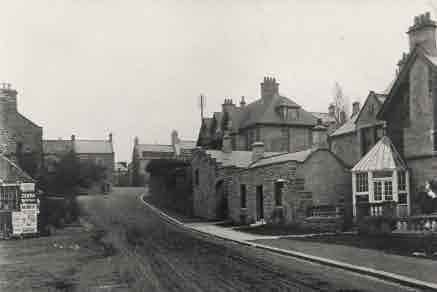
The Doctors surgery and house just north of the bridge c.1900
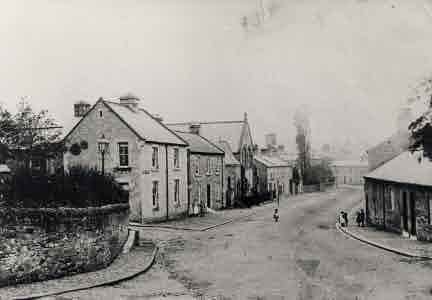
Princes Street c.1900
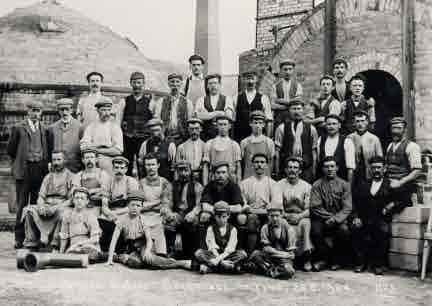
Pottery workers c.1904
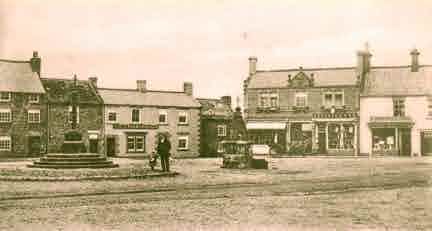
Corbridge Market place 1907
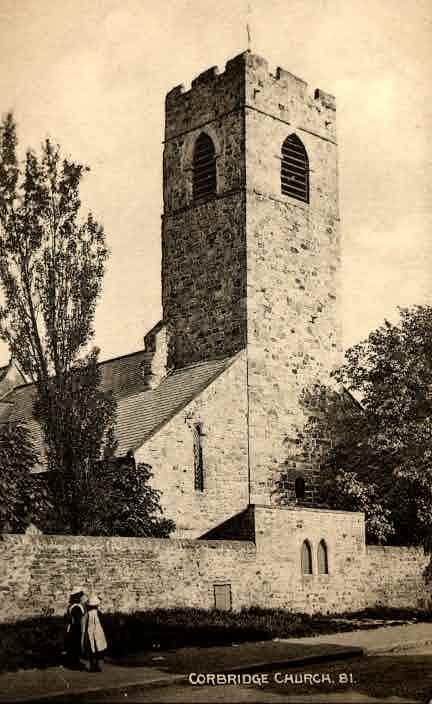
St Andrews church c.1910
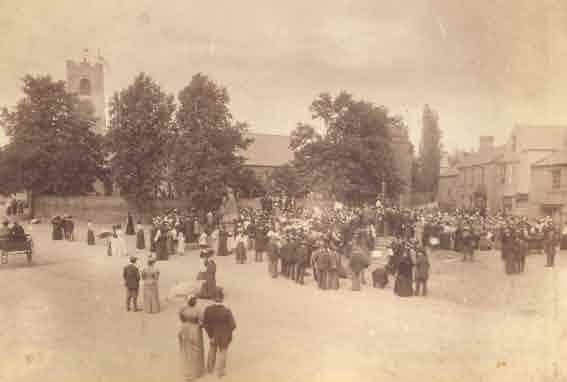
A gathering in the market place c.1910
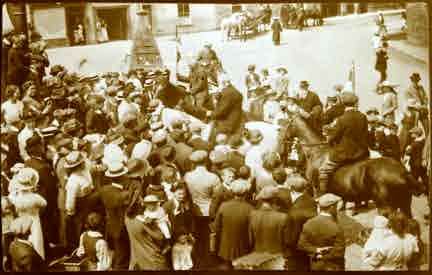
Proclamation of the fair c.1910
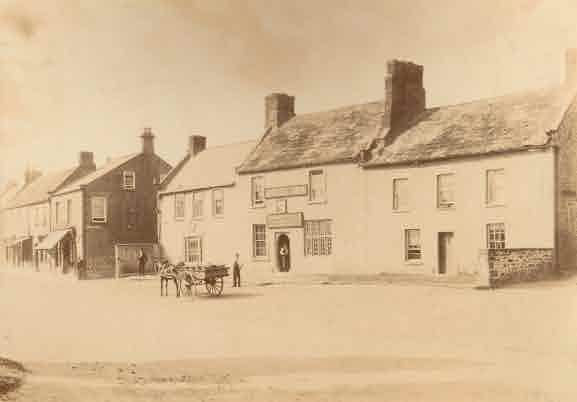
The Angel Inn c.1910
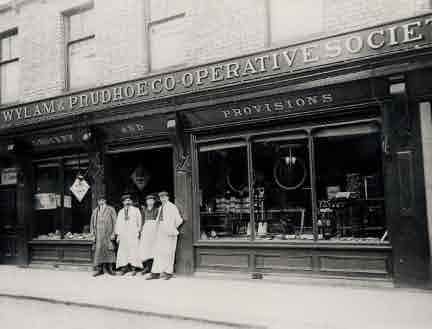
Corbridge, Wylam and Prudhoe Co-operative
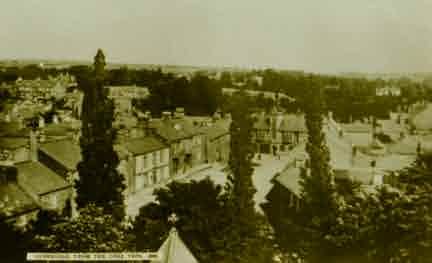
Aerial view c.1915 from the church tower
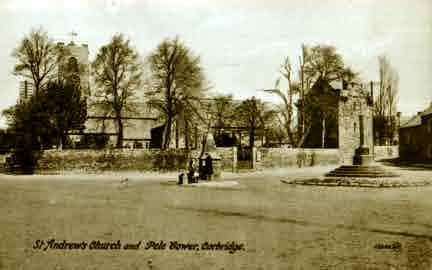
Church and Pele tower c1920 also the pant (fountain) and market cross
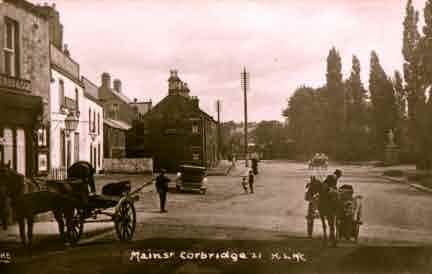
Main street c.1930 horse, cart and motor cars sharing the road
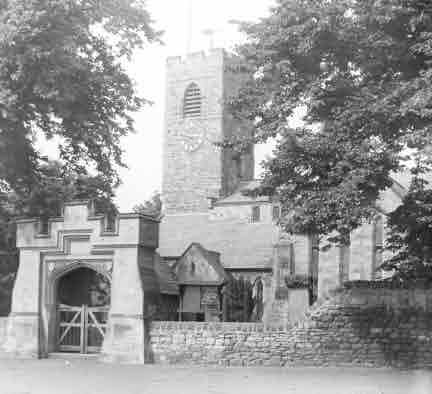
St Andrews c.1930

Corbridge Town hall c.1970
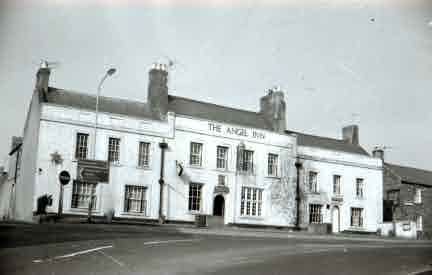
The Angel c.1970
The quarry is very close to Aydon castle, the map is dated 1828.